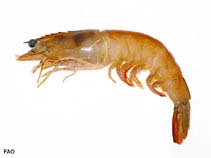Penaeus subtilis (Pérez Farfante, 1967)
Southern brown shrimp
Classification / Names Common names | Synonyms | CoL | ITIS | WoRMS
Malacostraca | Decapoda | Penaeidae
Environment: milieu / climate zone / depth range / distribution range Ecology
Benthic; brackish; depth range 1 - 190 m (Ref. 8). Tropical; 23°N - 24°S, 86°W - 34°W
Distribution Countries | FAO areas | Ecosystems | Occurrences | Introductions
Western Atlantic: from the Antilles and Honduras to Brazil.
Length at first maturity / Size / Weight / Age
Maturity: Lm 5.8, range 13 - ? cm Max length : 16.5 cm TL male/unsexed; (Ref. 8); 20.5 cm TL (female)
Maximum carapace length: 3.6 cm (male); 5.5 cm (female) (Ref. 8). Maximum total length (male) from Ref. 106295. Inhabits bottom mud and mud with sand or shells. Adults live in marine environments. Juveniles usually estuarine and marine, sometimes hypersaline (Ref. 8). Adults also found in an estuary (Ref. 67428). Burrows. Exhibits diurnal activity (Ref. 105090). In general, the majority of penaeids are omnivorous or detritus feeders (Ref. 105082), although this species shows preference for animal protein (Ref. 106970).
Life cycle and mating behavior Maturity | Reproduction | Spawning | Eggs | Fecundity | Larvae
Members of the order Decapoda are mostly gonochoric. Mating behavior: Precopulatory courtship ritual is common (through olfactory and tactile cues); usually indirect sperm transfer.
Main reference
References | Coordinator | Collaborators
Holthuis, L.B. 1980. (Ref. 8)
IUCN Red List Status (Ref. 130435)
CITES status (Ref. 108899)
Not Evaluated
CMS (Ref. 116361)
Not Evaluated
Threat to humans
Human uses
Fisheries: commercial
FAO - Fisheries: landings, species profile | FIRMS (Stock assessments) | FishSource | Sea Around Us
Tools
More information
Internet sources
BHL | BOLD Systems | CISTI | DiscoverLife | FAO(Fisheries: species profile; publication : search) | Fishipedia | GenBank (genome, nucleotide) | GloBI | Gomexsi | Google Books | Google Scholar | Google | PubMed | Tree of Life | Wikipedia (Go, Search) | Zoological Record
Estimates based on models
Preferred temperature
(Ref. 115969): 23.4 - 27.6, mean 26.5 (based on 124 cells).
Resilience
(Ref. 69278):
High, minimum population doubling time less than 15 months (K=1.06-1.1).
Prior r = 0.93, 95% CL = 0.62 - 1.40, Based on 6 data-limited stock assessments.
Nutrients: Calcium = 109 [35, 184] mg/100g; Iron = 1.59 [1.21, 1.97] mg/100g; Protein = 20.2 [19.2, 21.3] %; Omega3 = 0.285 [0.185, 0.386] g/100g; Selenium = 48.3 [-31.7, 128.3] μg/100g; VitaminA = 0 μg/100g; Zinc = 1.79 [1.17, 2.40] mg/100g (wet weight).



